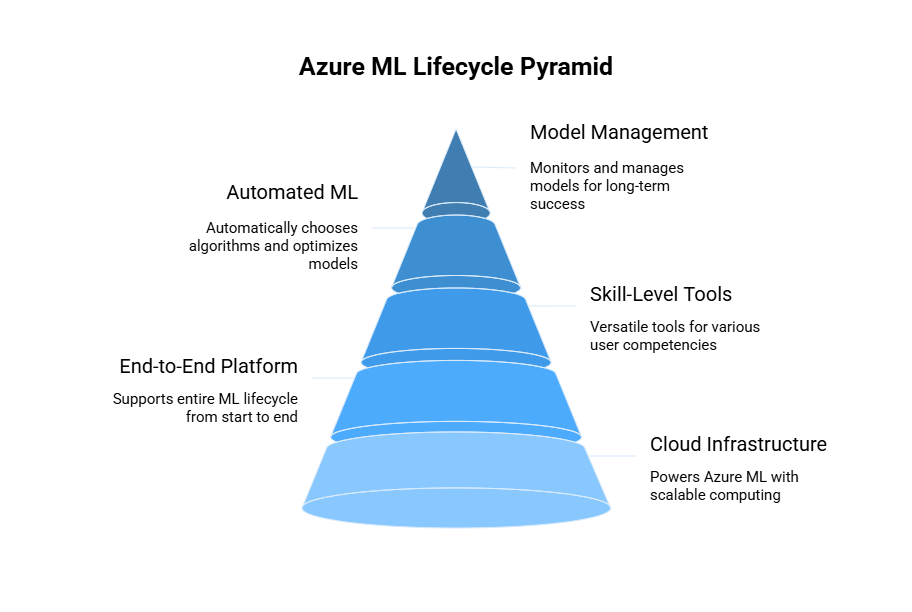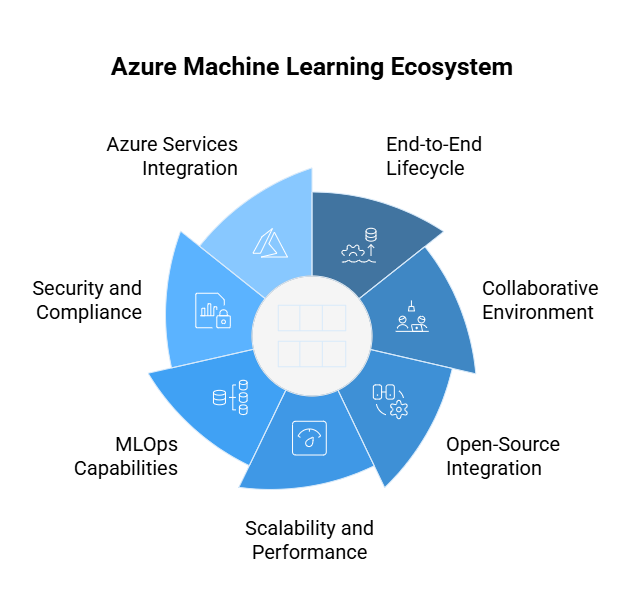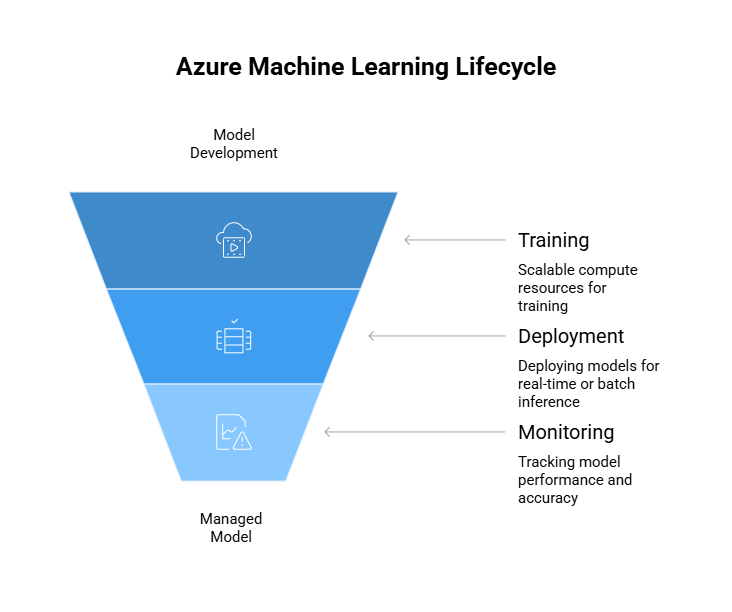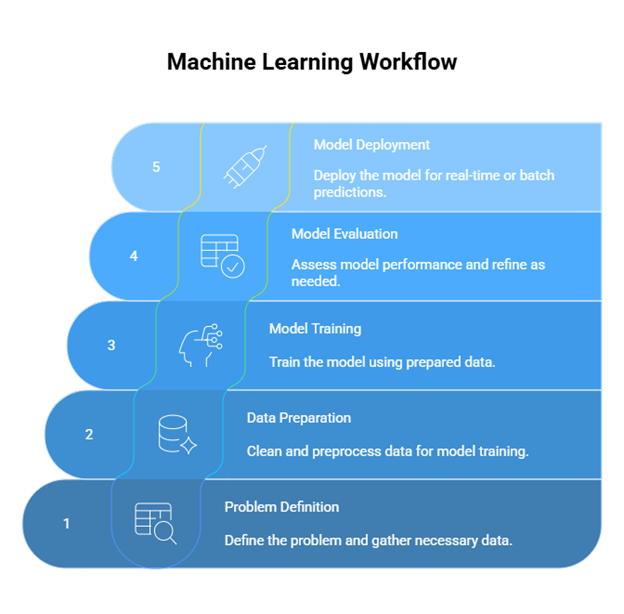What is Azure Machine Learning: A Beginner’s Guide

Machine learning is no longer just a catchword; it is a crucial technology that changes industries, automates processes, and supports intelligent decision-making. But for most beginners, it would be overwhelming to go deep into machine learning because of technical complexity and steep learning curve. Here Azure Machine Learning comes for rescue. As a service on Microsoft’s Azure cloud platform, it is there to ease individuals and organizations in building, training, and deploying machine learning models, without needing deep data science expertise or large-scale computing resources.
This guide is beginner-friendly in explaining what Azure’s Machine Learning is, how it works, and why a beginner would favor this starting path in exploring artificial intelligence (AI) knowledgewise. Great flexibility is granted by this technology, from intuitive drag-and-drop UI tools to automatic training of models to scalable cloud infrastructure, so users at any level could work with Machine Learning in Azure.
Developers, data analysts, and business executives alike would be able to use this platform to improve their businesses and explore possibilities with machine learning on the real problems around them. Learn how Azure-driven Machine Learning makes AI development pretty easy and how you could start off today.
Table of Contents
What is Azure Machine Learning?
Azure Machine Learning Services is a cloud-platform geared toward building, deploying, and managing machine learning models at scale. It provides a full suite of tools, which cover all aspects of the machine-learning lifecycle-from data preparation and Model training to deployment, monitoring, and retraining.
Seamlessly integrating into the larger Azure ecosystem, Azure AI platform caters to users of various competencies-from data scientists to business analysts. Equipped with scalable infrastructure and autoML, plus an easy-to-navigate user interface, it empowers organizations to build AI with ease and security.

Cloud-Based and Scalable Service
Microsoft Azure is the cloud infrastructure platform that powers Azure ML; hence users do not have to worry about physical installation of servers and hardware. Being cloud-based, Machine Learning in Azure can dynamically scale computing powers based on workloads.
Be it for some simple dataset or huge enterprise-level AI project, the platform assures resizing to support compute and storage requirements. This flexibility positions it for usage in companies of any size, providing cost-conscious solutions without compromising on reliability, high availability, and security.
End-To-End Machine Learning Platform
Unlike independent tools that focus on only certain aspects of a project, Azure ML supports the entire machine learning lifecycle from start to end. It lets users perform data cleaning and transformation, pick algorithms, train models with popular frameworks such as TensorFlow or PyTorch, and deploy the model into production environments.
After deployment, such models can be monitored and drift-detected for performance via this platform, ensuring model accuracy is retained over time-a full-cycle service that streamlines MLOps and gives teams the flexibility to innovate rather than build infrastructure.
Tools for All Skill Levels
Perhaps one of the strongest aspects of Azure Machine Learning is the versatility it offers for various types of users. Developers and data scientists have the code-first experience using Jupyter notebooks, the Python SDKs, and REST APIs. Business analysts and non-developers, in contrast, can use Azure ML Studio, a low-code/no-code environment with drag-and-drop features to build models visually. This democratized approach guarantees that persons of any technical capabilities can jointly work on AI projects using Azure ML.
Automated Machine Learning or AutoML
The growing field of machine learning with various needs for sophisticated tools is increasingly becoming confusing for some users with just Uber Machine Learning AutoML capabilities. AutoML helps users automatically choose the best algorithms, optimize model performance, and generate evaluation metrics, all without requiring users to write complicated lines of code. This is particularly useful for organizations that need to build machine learning solutions on the fly, quickly, or efficiently. Thus, AutoML is used in expediting the development with little manual effort so that even novices can develop an accurate and reliable model.
Model Management and Monitoring
Deploying a model is just one side of the coin, with monitoring being key to the success of the model in the very long term. To accomplish this, Azure Machine Learning comes to the rescue with very good capabilities for version control, real-time monitoring, and analysis. It is able to detect model drift, trigger retraining tasks, and maintain compliance by way of audit logs and governance. Such a way of managing solutions helps make sure that machine learning solutions continue to work and become credible in real-world scenarios.
Get started with Azure ML
Key Features and Capabilities of Azure Machine Learning
Machine Learning in Azure is a full-fledged, cloud-based platform that helps in creating, deploying, and managing machine learning models with ease. It is a service intended for data scientists, developers, and business users possessing an extensive set of capabilities that support the entire machine learning lifecycle. Using compute power at its disposal alongside open-source tools and Azure services to the fullest, ML helps organizations build scalable, secure, and efficient AI solutions. Below is a list of key features and capabilities that make this technology well suited to machine learning efforts.

End-to-End Machine Learning Lifecycle
Azure Machine Learning has many strengths but the strongest are its capabilities to provide full life-cycle support for machine learning programs. This life-cycle cycle includes data ingestion, preparation, training, evaluation, deployment, and monitoring. Users can bring their data from almost any location they please; using built-in data wrangling tools, transform it, prepare it in any way through Azure Data services; and train their model either with auto-training or manual training. Once their model is trained with a certain algorithm, it can be deployed to an environment either on the cloud for on-premises, edge, or device endpoints. Azure ML also provides support for versioning and performance monitoring so that one can be assured of the model’s accuracy and effectiveness as time elapses.
Collaborative environment
Azure Machine Learning makes Azure ML Studio a collaborative platform for data scientists, developers, and business analysts. The web-based environment enables users to build, train, and deploy models using an easy drag-and-drop interface. Team members can collaborate on projects, track experiments, and reuse pipelines for easier manipulation of complex AI workflows. Integration with GitHub and Azure DevOps allows teams to perform source control and continuous integration, which translates to better coordination and efficiency in project management.
Open-source Integration
One of the key advantages of ML in Azure is the flexibility it provides to include open-source tools and frameworks. Users can work with familiar libraries such as TensorFlow, PyTorch, and scikit-learn, and use their custom packages and environments. Azure Machine Learning supports Jupyter notebooks, Python SDKs, and command-line interfaces; developers can code using whatever tools they like. Such an open ecosystem allows organizations to capitalize on existing skills and codebases, helping with quicker adoption and shedding longer learning curves for their machine learning projects.
Scalability and Performance
By leveraging the power of the Azure cloud, Azure’s Machine Learning thus enjoys almost unlimited scalability and performance. It allows users to spin up compute clusters on-demand, from CPU and GPU VMs to FPGA VMs for heavy loads and complex models. The users can train distributed code so that their models may train relatively quickly in parallel over multiple nodes. Azure ML is, therefore, the method of choice for small proof-of-concept model building and for building enterprise-scale AI systems, allowing users to achieve consistent performance and efficient usage of resources at scale.
MLOps Capabilities
Operationalizing machine learning models is among the quintessential challenges for enterprises; and Azure-oriented Machine Learning shines here, providing MLOps capabilities. The platform automates model deployment, versioning, monitoring, and retraining, so that organizations can maintain model accuracy and reliability in production. The user can automate the end-to-end workflow from data ingestion to deployment through Azure ML pipelines, thus preventing manual intervention and improving efficiency. ML in Microsoft also enables users to set up monitoring of different metrics, including accuracy, latency, and data drift.
Security and Compliance
Security is something to be given utmost importance in this machine learning project, and Azure Machine Learning is very much an enterprise-grade secure platform. It employs role-based access control (RBAC), virtual networks, and private link support to maintain the sanctity of data being accessed through compute resources. Being compliant with a slew of worldwide compliance standards such as GDPR, HIPAA, ISO/IEC 27001, and SOC 2, it just offers solace to organizations concerning data privacy and governance. Model deployments are also secured and audit trails maintained so that regulatory compliance can be maintained in industries.
Integration with Azure Services
Unmatched seamless integration with other Azure components is the key benefit of Microsoft Machine Learning. It integrates well with Azure Data Lake Storage for data management, Azure Databricks for data engineering and analytics, and Azure Kubernetes Service (AKS) for scalable model deployment. Through these integrations, users can develop end-to-end machine learning solutions with existing data and application workflows. The interconnectedness in this environment substantially increases productivity, diminishes complexity, and helps to speed up the delivery of business solutions powered by AI.
How Azure Machine Learning is Used?
Machine Learning Azure provides everything needed for the complete life cycle of a machine learning algorithm, from development, training, deployment, and management. For the very inexperienced who want to learn with visual tools and more experienced data scientists who want to code inside notebooks, the platform is made to flexibly and scalably fit various workflows. Discussed below are how they are basically applied across four critical stages: developing, training, deploying, and monitoring machine learning models.

1. Model Development
Building Models Using Visual Tools and Code-Based Interfaces
The model is designed to suit different user preferences and skill levels. For people that feel comfortable coding, Azure ML presents Jupyter notebooks and Python SDKs so they can write individual scripts, experiment with various algorithms, and tune hyperparameters. Developers can import pre-trained models or bring in code from open-source frameworks: TensorFlow, PyTorch, or Scikit-learn.
For more low-code-oriented users, the Azure ML Studio provides a visual drag-and-drop interface to create machine learning models without writing a single line of code. This allows business analysts and domain experts to develop AI together with data scientists and fosters a more synergic workflow.
2. Training
Scalable Compute Resources for Model Training
Lots of computational power is needed to train machine learning models, especially when working with large datasets or deep learning models. Azure Machine Learning meets this need by providing Azure cloud computing resources with scalable compute dimensions and virtual machines enabled for both CPU and GPU.
Users can select the compute instances for their own development and experimentation or subtract compute clusters for massive model training. These resources can be scaled up and down dynamically, in terms of performance and cost. Also, Azure ML supports distributing training to multiple nodes, minimizing the period in training complex models quickly, thereby making faster iteration and experimentation.
3. Deployment
Deploying Models for Real-Time or Batch Inference
Deployment, after the model has been trained and evaluated, is straightforward with Azure ML. Models can be deployed as web services with Azure Kubernetes Service (AKS) or Azure Container Instances (ACI), and predictions can be served in real-time through REST APIs. This enables applications or users to interact with the model instantly, making this perfectly suited for AI features facing the customer like recommendation engines or chatbots in the cloud.
For large-scale data processing, batch inference pipelines can be considered. These would, in a single step, allow the model to go through datasets in bulk, yielding results in an efficient manner, whether scheduled or on demand. Azure ML supports deployments to cloud, the edge, or even on-premise, so the users have the liberty to choose how and where their models run.
4. Monitoring and Management
Tracking Model Performance and Ensuring Long-Term Accuracy
Deployment does not end in itself. The model is managed over time to ensure that the accuracy is maintained. Azure’s Machine Learning has provisions for monitoring of the deployed model in real-time, allowing users to monitor certain KPIs such as latency, accuracy, and resource utilization.
Furthermore, Azure ML supports data drift detection, wherein users would be alerted when data coming in starts to shift away from the data used in training the model. Thus, it is imperative to recognize when it might be time to retrain. It is an automated approach to retraining, ensuring that models remain accurate and serve effectively, forming the backbone of MLOps in any corporation.
Understanding the Machine Learning Workflow
A machine learning (ML) workflow is a structured process that guides the development, training, deployment, and maintenance of machine learning models. Such an approach ensures model building that’s efficient and reliable and, depending on scalability and improvements, may be limited. ML workflows convert raw data into operational insights through clever models. The following stages are the essentials in a typical machine learning workflow.

1. Problem Definition and Data Acquisition
It starts by defining the problem at hand—whether prediction of churn or anomaly detection. Then, when the objective is made clear, practitioners would proceed with searching for data sources and collecting them. Consideration is also given at this stage as to whether the data at hand meets the requirements of the intended model or if further data collection is necessary.
2. Data Preparation
Raw data generally contains missing values, outliers, or inconsistencies, giving importance to cleaning and preprocessing of data. The data is then converted to a format suitable for model training. This process involves feature engineering, where new features are derived from existing data to enhance model performance.
3. Model Training and Validation
Here, a suitable machine learning algorithm is chosen, and the model is trained using the prepared dataset. It is, then, validated on another dataset to avoid overfitting and ensure that it generalizes well with new, unseen data.
4. Model Evaluation and Refinement
The evaluation is based on performance measures like accuracy or precision. The model is allowed to learn from its evaluation and, depending on the outcome, can be returned with hyperparameters or the algorithms themselves.
5. Model Deployment and Monitoring
Afterward, the model goes into production to do real-time or batch predictions. A continuous monitoring process guarantees that the model remains accurate. Therefore, retraining may be compulsory when the data or the condition changes.
Azure Machine Learning Use Cases
Azure ML is the platform that serves various industries by supporting data-driven decision-making, automation, and intelligent prediction. It is therefore flexible, scalable, and easily integrated with other Azure services, making it the choice for organizations looking for AI integration in real-world applications. Below are some of its use cases in various industries that rank among the most impactful.
Healthcare: Enhanced Diagnosis and Patient Care
Azure Machine Learning in Healthcare: Imaging and Diagnostics
Radiologists typically interpret complex images like X-rays, CTs, or MRIs; however, machine learning models provide a layer of interpretation with a greater degree of accuracy. There are Azure ML models that can realize the anomalies in the early stages: tumors, fractures, signs of diseases, etc. Hence, the process leads to a faster and more accurate diagnosis and ultimately improves treatment outcomes and saves lives. Then, one can model predictive analyses for the expected progression of diseases or risks of patient readmissions, which allows for personalized care plans.
Financial services: Risk analysis and credit scoring
Azure ML is of paramount importance in the financial sector due to its ability to tap into customer data for making risk assessments and delivering personalized services. Financial institutions look into transaction history, credit history, expenditure patterns, etc., to study customer behavior and use it for their decision making. The credit scoring models built with Azure ML assess the creditworthiness of the borrower thus reducing risks of loan defaults. Also, fraud detection models are trained so that any suspicious activity can be detected in real time, keeping the security and compliance of the system intact.
Manufacturing: Predictive Maintenance and Quality Control
Manufacturing companies use Azure Machine Learning to optimize operations through predictive maintenance. Azure ML analyses data collected from sensors attached to the equipment and predicts when the machines will fail or require servicing. Such a proactive approach even restricts unscheduled downtimes, eventually leading to a longer life for the machinery. Azure ML models can also be deployed in quality control in real time to detect defects in products as they move down the production line, thereby ensuring that only the best quality product reaches customers, bolstering brand reputation, and cutting down wastage.
The Retail Forecast-An Inventory and Demand Planning Exercise
Accurate demand forecasting is developed with Azure’s ML in retail by analyzing historical sales, market trends, and behavior patterns of consumers. Depending on what products will be sought and when, retailers can use this software to optimize their inventory levels, avoiding stockouts or overstocking, thus creating customer satisfaction and smooth supply chain operations. Marketing strategies that are personalized may also work to uplift customer interaction and spur sales, using insights from Azure ML.
Energy Consumption Optimization: Cost-Reduction and Sustainability
Energy companies and several large organizations use Microsoft’s Machine Learning for analyzing historical energy consumption values and estimating energy consumption in the future. Energy demand forecasts allow optimizing the consumption of energy, thus reducing the operational costs of the company, and also in achieving the goal of energy efficiency. The Azure ML allows supporting demand forecasts for renewable energy sources and smart grid management to help with environmentally friendly business practices.
Customer Churn Prevention: Keeping Loyal Customers
Various industries utilize Azure-driven Machine Learning to forecast the possibility of their customers churning. Azure ML models analyze various parameters of customer interaction data, buying behavior, and any complaints, in order to identify users more likely to discontinue the service. The companies then initiate appropriate retention campaigns, personalized offers, or proactive support for these valuable customers, which in turn helps in creating long-term loyalty and revenue.
Supply Chain Optimization: Logistics and Delivery at Its Finest
Azure Machine Learning ensures supply chain optimization by analyzing data resulting from the effects of geology in logistics, inventory, and external parameters such as weather or geopolitical risks. Companies can foresee interruptions, optimize delivery routes, and better manage inventory. Real-time insights reduce decision times, thus cutting delays and costs right across the supply chain. Operations run smoothly, and goods are dispatched on time.
Human Resources: Smarter Talent Acquisition
Azure’s cloud-based Machine Learning can be applied in the Human Resources department to automate and optimize talent acquisitions. Resumes, job descriptions, and historical hiring data can be analyzed by Azure ML models that assess candidates for the best fit for certain roles. This shortens recruitment cycles and improves on the quality of hiring based on the potential for a candidate to succeed. The built-in bias detection tools of Azure ML can further help make it a fair and inclusive hiring procedure.
Telecommunications: Network Optimization and Service Reliability
Telecommunications providers resort to Azure Machine Learning for analyzing network data and predicting potential service disruptions. By monitoring metrics in network performance, Azure ML can identify the weakest points in the network and offer optimization measures to increase service reliability. Another area of improvement efficiency and customer satisfaction brought by Azure ML is predictive maintenance of network hardware and bandwidth management.
E-commerce: Personalization and Customers’ Priorities
E-commerce platforms utilize Azure ML platform for personalizing shopping experiences. By processing customer behavior, browsing history, and previous purchases, Azure ML models provide recommendations of products tailored or fit to the needs of a particular customer. The different interactions help increase conversion rates and average order value. Dynamic pricing and targeted marketing make Azure ML even more important for e-commerce to maintain competitiveness in response to market needs.
Explore Azure ML now
What is Azure AI Studio?
Azure AI Studio is a powerful platform created by Microsoft that enables the construction, training, deployment, and management of AI applications, from intelligent copilots to generative AI solutions. In the broader context of Azure, Azure AI Studio is the front-end to Microsoft’s robust cloud infrastructure that integrates into services like Azure Machine Learning, Azure OpenAI, and Azure Data services. The platform caters to the needs of technical users and business professionals, providing a low-code environment packed with pre-built AI models, simple data-preparation tools, and streamlined workflows for model training and deployment.
Azure AI Studio reduces technical barriers in custom AI solution development by offering templates, drag-and-drop components, and integration into popular AI frameworks. Hence, users can create virtually any application from simple chatbots and predictive analytics to complex generative AI use cases-worry-free about lengthy coding. Moreover, the platform provides adherence to responsible AI practices that facilitate monitoring, bias detection, and compliance management.
Through Azure AI Studio, the enterprises can rapidly
prototype, scale, and manage AI-driven solutions across industries. Azure AI Studio enables innovation and deployment of AI, offering a suite that is flexible and scalable with tools to create intelligent customer service agents, automate business workflows, and build personalized experiences for the end-user.
Azure AI Studio vs. Azure Machine Learning: Selecting the Right Platform for Your AI Wish.
Businesses are quickly being transformed by AI, going all the way from automation and analytics to natural language understanding and generative AI. Microsoft has created two strong platforms with the concept in mind: Azure AI Studio and Azure-driven Machine Learning to elevate AI from a mere idea into workflows of various organizations. Both platforms cater to AI solutions-on their development and deployment-but consider different use cases and user types.
They are fundamentally different from an Azure AI Studio stand to Azure ML. This will help you decide on the right AI tool for your projects. This guide lays down the fundamental differences and offers a decision stratum based on purpose, features, and best use cases for each.
Azure AI Studio: Making AI Available for Application Developers.
Focus: Pre-built AI for Integration into Application Development
Azure AI Studio is an on-cloud creation that supports smoother implementation of AI in applications. It draws emphasis on using AI pre-built models and APIs to imbibe intelligent features in software solutions such as image recognition, speech-to-text, text analysis, and conversational AI. Hence, Azure AI Studio allows developers to create AI applications without needing much expertise in machine learning and thus without building models from scratch.
It comes especially handy for organizations that want to quickly enhance the user experience or automate tasks using Generative AI, Cognitive Services, and Azure OpenAI capabilities.
User Base: Developers, IT Professionals, and Citizen Developers
Azure AI Studio is geared for application developers, IT teams, and business users interested in incorporating easy AI features into their apps with very little machine-learning know-how. Azure AI Studio is a low-code environment, meaning that an average Jane can use it, with no data-science background.
Developers then, in my view (because obviously no one is going to stand firm on its definition any other way), build AI copilots-interactive assistants embedded into applications-using drag and drop tools and pre-built models.
Key Features of Azure AI Studio
- Pre-Trained AI Models: Access to ready-to-use models like vision (object detection, OCR), speech (speech-to-text, text-to-speech), and language (translation, sentiment analysis, summarization).
- Generative AI with Azure OpenAI: Intense generative models like GPT, DALL-E, and Codex can be used by the users in building intelligent assistants or content-generating programs with summarization.
- Low-Code Environment: Easy menu makes it possible for anyone to insert AI in apps using APIs and graphical tools. There’s no building of complex machine learning pipelines required.
- Deployment and Management Tools: Azure AI Studio comes with builtin controls for endpoint management, usage metrics, and deployments with scaling and monitoring sprinkled in for good measure.
- Integration with Azure Ecosystem: Azure AI Studio flexes with services like Azure Logic Apps, Power Apps, and Azure Functions to build end-to-end AI-driven workflows.
Typical Use Cases
Some use cases for ML are:
- Building AI-powered chatbots and customer service agents.
- Providing e-commerce platforms with personalized product recommendations.
- Adding speech recognition and language translation to applications.
- Providing AI copilots for productivity tools.
- Generating content using Azure OpenAI models.
Azure-Azure Machine Learning: Custom Model Development for Experts
Focus: Full Control over Machine Learning Lifecycle
Azure’s Machine Learning is the Microsoft enterprise software platform to build, train, deploy, and manage custom machine learning models. In contrast to Azure AI Studio, which works with pre-built models, users develop their own models from scratch using Azure Machine Learning, experiment with algorithms, tuning of hyperparameters, and push those into production.
In addition, it covers all phases of development life: ingestion, training, evaluation, deployment, and continuous monitoring.
User Base: Data Scientists, ML Engineers, and AI Researchers
AI in Machine Learning caters to data people who already know machine learning concepts, programming, usually Python and R, and know how to develop models. It is a code-first experience, though it supports low-code options through Azure ML Studio as well.
Machine Learning in Azure is used when an organization has data scientists or requires an advanced AI solution for which it can provide flexibility, scalability, and control.
Key Features of Azure Machine Learning
- Comprehensive Development Environment: Supports Jupyter notebooks, Python SDKs, command-line tools, and visual interfaces for project management.
- Framework Support: Supports all major machine learning frameworks, including TensorFlow, PyTorch, Scikit-learn, and XGBoost.
- Data Preparation Tools: Users prepare datasets using Microsoft Machine Learning tools or external services such as Azure Data Factory and Azure Synapse for cleaning, transformation, and analysis.
- AutoML: AutoML techniques allow for the automatic training and tuning of models to select the best algorithms for the data.
- Model Explainability and Fairness Tools: The set of built-in tools guides the users in understanding the models, detecting possible biases, and ensuring responsible AI practices.
- MLOps Features: Azure Machine Learning has all the tooling for MLOps, including versioning control, model monitoring, CI/CD integration, and automated retraining.
- Deployment Options: Models can be deployed to Azure cloud services, on edge devices, or on a containerized on-premise infrastructure.
Typical Use Cases
- Custom predictive analytics: fraud detection, demand forecasting, customer segmentation.
- Deep learning training for image classification, speech recognition, and NLP.
- AI-based recommendation systems, custom-built for specific business requirements.
- ML models operationalized with real-time monitoring through CI/CD workflows.
- AI research and experimentation on scalable cloud environments.
Which Platform Should You Choose?
- Choose Azure AI Studio when you want to rapidly infuse your applications with AI features, prepared with ready-made models and APIs. It ideally suits developers and business users working on application enhancement rather than on model creation.
- Choose Azure Machine Learning if you need to build, train, and manage custom machine learning models, especially for the more complex and enterprise-grade projects. It is designed for data scientists and ML engineers who require control on all aspects of the lifecycle of machine learning.
Understanding your teams’ skills, project complexity, and business objectives would place you in a position to select the platform that delivers the most value and would accelerate the journey in the world of AI in the cloud. If you want case studies based on real companies or a comparison guide downloadable for your audience, please let me know.
Conclusion
Azure Machine Learning is an enterprise-grade platform for large-scale custom machine learning development and deployment. In other words, given an ML recipe, data scientists or machine learning engineers can provision an environment to complete the entire ML lifecycle; to include activities like data preparation, training, deployment, and monitoring, all the while being secured and scalable in the cloud. It supports popular open-source frameworks, offers AutoML, and provides a full suite of MLOps capabilities at your disposal to build sophisticated AI solutions aiming for specific business needs.
Productivity is further enhanced through tight integration with other services in the Azure ecosystem to enable real-time insights, intelligent applications, and smooth workflows. If your objective is to gain operational efficiency, forecast customer attraction, or automate multi-step complex customer operations, it has all the tools and infrastructure to turn your data into actionable intelligence. Azure Machine Learning is one powerful platform to enable innovation and execution of business outcomes in meaning as AI keeps on growing. For further details or to book a consultation, you can visit us here.
Frequently Asked Questions
1. What is Azure ML?
Azure Machine Learning represents a cloud service out of Microsoft Azure for users to create, train, deploy, and manage machine learning models. It stands as the all-in-one environment for every step in the machine learning journey, from data prep to model building, deployment, and performance monitoring. The platform is great with the major machine learning frameworks-under TensorFlow, PyTorch, and scikit-learn-and it smoothly integrates with a host of other Azure services, thus aiding faster and scalable AI solution development.
2. What is Azure ML Studio?
Azure Machine Learning Studio is a browser-based interface that is a part of the greater Azure Machine Learning platform. It offers an easy-to-use, visual environment for the design, construction, and deployment of machine learning models. Users can create end-to-end machine learning workflows using drag and drop interfaces, which is very gut feeling for beginners, while code-first is available for more complex, custom solutions. It is that flexibility that makes Azure ML Studio ideal for beginners just entering the optimization domain or for data scientists looking for a simplified and integrated work environment.
3. Is Azure machine learning cloud-based?
The Azure Machine Learning service is a cloud-based offering for automation and management of the whole ML project life cycle. It allows data scientists, ML engineers, and AI experts building machine learning models, training them, deploying those models, and then monitoring their behavior within a scalable cloud environment. The platform performs usual day-to-day activities like experiment tracking, model versioning, and deployment management, as well as providing mechanisms for automating and optimizing MLOps. Azure cloud infrastructure allows computing resources to be placed at users’ disposal, collaboration amongst teams to be fostered, and faster building of robust AI applications.



